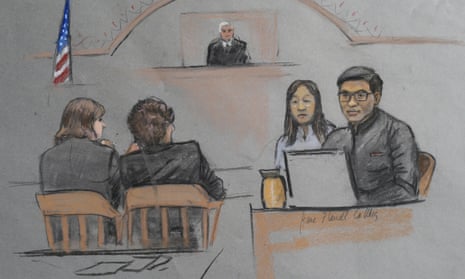Few people outside the medical and military professions will ever be in the position to make a truly life-or-death decision. But the 12 jurors in the trial of Dzhokhar Tsarnaev will likely face one head-on.
Tsarnaev, the younger and only surviving of two brothers accused of perpetrating the 2013 Boston Marathon bombing, faces 30 charges related to the attack and subsequent manhunt, several of which carry a potential death sentence.
The prosecution is working through its narrative – moving slowly, in loose chronological order, through the events that followed the detonation of two pressure-cooker bombs at the finish line of the Boston Marathon.
Watching the trial play out in a federal courthouse by the waterfront in Boston, not two miles from where the bombs went off, it is impossible to escape the conclusion that some sleight-of-hand is at play. Proceedings have, in a sense, been a dumb show, a ritualistic performance in which both prosecution and defence are thinking tactically, like chess grandmasters, about the endgame ahead.
Tsarnaev’s defence lawyer, Judy Clarke, known for helping clients escape the death penalty, practically said as much in her opening statement. She stressed it was not her aim to contest “the who, what, where and when” of the government’s case – “only the why”.
“It was him,” she said. At that moment, though Tsarnaev had entered a “not guilty” plea, he essentially pleaded “guilty” by proxy.
It was a very clever move. This way, Clarke gets the time in court and the opportunity to build her narrative, her picture of Tsarnaev and his motivations, to the jury. If a guilty plea had been entered, there would be no need for a jury trial.
She also has the chance to undermine trust in the prosecution. The opportunity has already arisen: in a truly spectacular unforced error by the government, an FBI special investigator collapsed under cross-examination last week and admitted, among other things, to not having even looked at a picture of Mecca before testifying that it was what was pictured at the top of Tsarnaev’s Twitter account. It was not: it was a mosque in Grozny.
The back and forth about the meaning and context of Tsarnaev’s tweets – in which the same tweets under different questioning looked either threatening and callous or universal and banal – showed the tactical undercurrents at play.
In this courtroom, Tsarnaev’s actual guilt is far less in play than jury-grooming: building belief in one of the two competing narrative presentations through differing interpretive gloss on the same facts.
If Tsarnaev is found guilty in this first phase of the trial – the so-called “guilt phase” – the jury will then hear evidence and arguments on the question of whether to impose a death sentence, the so-called “penalty phase”. A vote for death must be unanimous.
Clarke is setting the scene for what the New York Times described as the “Svengali defence” – admitting Tsarnaev’s guilt but painting him as in thrall to a powerful older brother, Tamerlan. That’s the defendant she wants the jury to see.
Clarke, for example, always refers to Tsarnaev by his university nickname – “Jahar”. In her opening statement, she said Jahar would not “sidestep responsibility” for the attacks, but that “it was Tamerlan Tsarnaev who self-radicalised; it was Jahar who followed him”.
“The evidence will show you that while Tamerlan was … immersed in death and destruction,” she said, “Jahar spent most of his time on the internet doing things that teenagers do. Facebook, cars, girls.”
Ultimately, what happens in this trial will come down to which narrative can be presented most compellingly. Tsarnaev-with-agency or Tsarnaev-in-thrall. Villain or, in some sense, victim.
Clarke has long been opposed to the death penalty philosophically, as well as in court. Jonathan Shapiro, a colleague at Washington and Lee University law school, told the Guardian “the thought of the state being able to extinguish someone’s life” was “horrific” to her.
The narrative journey the prosecution is constructing began at the moment of the detonations, with heartbreaking testimony from witnesses and victims of the bombing, as well as shocking video from the day itself. Faced with testimony from a father who lost his eight-year-old son, or a double-amputee, jurors have occasionally been seen to wipe away tears.
From the devastation wrought by the two bombs on Boylston Street, the prosecution’s witness testimony has moved to the murder of MIT police officer Sean Collier and shootout with police, through gripping testimony from Dun Meng – the man the brothers carjacked after killing Collier – and the death of Tamerlan Tsarnaev under the wheels of a stolen car. It has been slowly creeping toward Tsarnaev’s arrest in a dry-docked boat in Watertown.
The defence has actually requested that the boat – on which Tsarnaev wrote a bloodstained manifesto while curled beneath the tarpaulin – be brought into the courtroom.
It may be too early to tell who will be more successful. But when the defence begins calling its witnesses, things may get really contentious.
Several parts of the case don’t look good for the government. One is the death of Ibragim Todashev, who was shot by FBI agents investigating his and Tamerlan’s alleged involvement in a bizarre and unsolved triple murder in Waltham, Massachusetts. This may not come off well in front of a jury.
The guilt phase of the trial is estimated to last five months, according to court officials. There will be plenty of twists and turns along the way. But as the trial progresses, it is important to keep the endgame in mind. Because ultimately, this isn’t really a trial about guilt or innocence. It is about life or death.

Comments (…)
Sign in or create your Guardian account to join the discussion